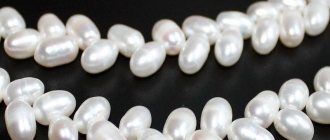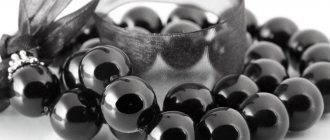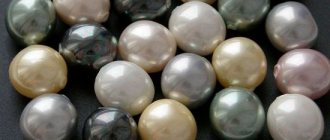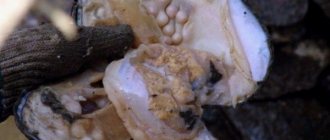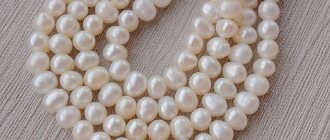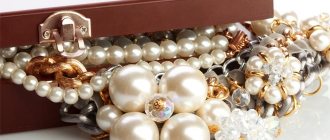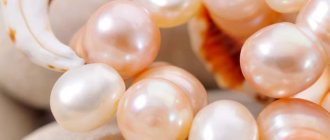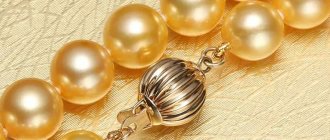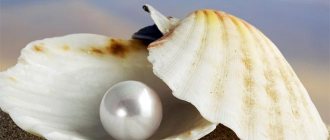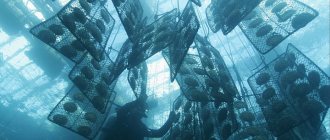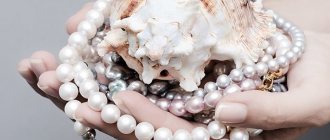For a long time, Russia was a leader in the production of pearls, a symbol of good luck and wealth. There was enough mother-of-pearl for both peasant women and court ladies, and there was still some left for export. And suddenly the palm in the extraction of organic minerals passed to Japan. Where are pearls mined in Russia now?
Pearl mining in Russia
HOW ARE PEARLS FORMED IN A SHELL
Wild pearls are produced in nature by some species of river and pearl species of marine mollusks. Only specimens covered with a layer of mother-of-pearl have commercial value. Not all mollusks have a shell with a pearl, but only:
- bivalve;
- some gastropods;
- one species of cephalopod;
- in freshwater representatives of the unionidae family (toothless, barley, folded comb).
Which shells contain pearls?
Bivalves are the main source and include:
- oysters;
- mussels;
- sea scallops.
Bivalves
Shells with shapeless pearls, called “baroque”, are mainly formed by river mollusks.
Pearls in shells in the form of a pear, oval, ball, blister (button) are found mainly in marine representatives.
The configuration depends on the location in the shell and is sometimes extremely bizarre, for example, “monsters” or “paragons” - formations in the form of animals or humans.
Why do oysters need pearls?
The origin of pearls is due to the presence of nacre on the inner walls of the shell. Since the mollusk feeds on filtered plankton, foreign bodies often get inside, for example, grains of sand. The oyster responds to the irritation by enveloping them in nacre, causing the mollusk to form a pearl.
How pearls grow
Foreign inclusions can be located between the mollusk's mantle and the shell valve or penetrate directly into the mantle - a fold of the body wall that is located between the visceral sac and the leg. We recommend: RAW AMBER for the thyroid gland
The growth of pearls
The fold forms a mantle cavity, communicating with the outside world and covered with epidermis. This layer produces nacre, covering the inside of the valves and any foreign bodies in concentric circles, isolating them.
- If a grain of sand adheres directly to the sash, the future pearl will be fused with it and nacre will not form in this place.
- If it penetrates into the mantle itself, a free round pearl will form. In the latter case, it is necessary that, along with the foreign body, epidermal cells also penetrate into the connective tissue of the mantle. They will begin to quickly divide, form a cyst (pearl sac) and begin to secrete nacre.
Interestingly, the mantle can form pearls without foreign inclusions; for this, it is enough to move the epidermis into the connective tissue: for example, as a result of mollusk pathology or mechanical damage from the outside.
Within 1-2 years, pearls grow in the shell, visible to the naked eye. Large natural pearls of precious categories mature over 10-12 years.
What is a pearl and what does it consist of?
The composition of pearls is close to the composition of shell nacre. In addition to the predominant calcium carbonate, it contains:
- conchiolin is an organic horn-like protein substance that forms the framework of the pearl and the outer layer of the shell;
- impurities of magnesium, manganese, titanium, strontium, zirconium, silver are characteristic of Crimean pearls.
Chemical composition of pearls
In this case, the layers of mineral (CaCO3) and conchiolin alternate and do not touch each other.
How many pearls can there be in one shell?
There can be up to several dozen pearls in a shell. So, in the shells of the Black Sea mussels there are over 100 pieces. The larger the number (over 100), the smaller their size (2.5-3 mm).
How to get pearls
Pearls that are obtained from oysters living in the natural environment are called wild pearls. In order to find the right oyster, professional divers descend many meters under water, to places where there are large concentrations of mollusks.
A pearl does not appear in the shell from the very birth of the oyster, but only as it grows, if suddenly a foreign body - a tiny grain of sand - penetrates the animal’s belly. To protect the insides of its body, the oyster begins to envelop the stone with mother-of-pearl, thereby softening the sharp edges.
A mollusk can spend decades polishing, applying layer after layer, an established bead. It is these “pregnant” mollusks that fishermen hunt for. In one freshwater oyster you can find up to several beads, and in a sea oyster - up to 10.
Pearl mining occurs all over the world. But the scale of production of wild stone is inferior to that of cultivated stone.
View this post on Instagram
Post by Decoration • ????????? (@lina_bijouofficial) May 28, 2019 at 6:22 PDT
Pearl divers
Pearl divers are brave and strong-willed people, because when diving into the depths of the water for oysters, they risk being injured and sometimes even losing their lives. Gem hunters have developed physical muscles and large lung capacity to be able to dive to a depth of 50 meters and hold their breath for more than a minute.
Professional divers have been training their skills since childhood. Sea fishermen often look older than their years because salt water and sudden changes in pressure negatively affect their health. Previously, the mortality rate among swimmers was much higher due to the lack of necessary modern equipment for this profession.
During the dive process, a person must be especially careful. In sea and fresh waters, many dangers await him - from poisonous animals to predatory fish.
Previously, to protect themselves from bites, catchers wore linen suits and gloves, and lubricated exposed skin with special oil.
Japanese ama girls are famous all over the world. These are professional divers who use a unique breathing technique. It allows them to go without air for up to two minutes. Their training includes physical and mental preparation. Ama women pass on their secrets for extracting minerals from shells from generation to generation.
To continue the topic, watch the video:
WHERE ARE PEARLS CULTIVATED?
Cultured pearls are obtained by growing on special plantations due to:
- introduction of an irritant that provokes the mollusk to secrete nacre;
- creating artificial conditions.
We recommend: PEARL MINING IN RUSSIA today
There are different methods for obtaining saltwater or freshwater cultured pearls.
Pearl farms
Huge garlands of shellfish are then suspended in a marine incubator on floats, where the precious material grows naturally. The shells are periodically turned over so that the mother of pearl is distributed evenly and the beads are perfectly spherical. Over the course of several years, real pearls appear in the oyster shell.
Pearl farms
Nuclear method
The formation of pearls can be with the use of a nucleus or without a nucleus. According to Japanese technology, introduced by the famous Mikimoto and patented in 1896, the shell flaps were slightly opened and small fragments of coral were introduced into it. Today, a mother-of-pearl ball made from the shell of a freshwater mollusk is used as a core.
Nuclear-free method
The birth of pearls can also be nuclear-free. In this case, pieces of the epithelium (epidermis) of another mollusk are introduced into the connective tissue of the mantle of one mollusk, as described above. The mortality rate of mollusks with a transplant ranges from 10 to 40%. If everything went well, the individual is placed in an incubator and waits for the jewel to appear.
Types of cultured pearls
In nature, pearls occur in several shades. Reddish, dark brown and violet-black material is found in the noble pinna. In addition, different mollusks form different pearls:
- abalone - oval white and blue-green with a strong shine;
- common chalk - round yellow-orange;
- buccinum vulgaris - pale colored;
- gastropods - shiny.
Haliotis
They cultivate mainly white, black, gold and akoya.
Akoya
This species is grown in the bivalve shells of mollusks of the genus Pinctada, the Japanese call them “akoya-kai” - hence the name. The characteristics of the material are as follows:
- size - 6-8 mm;
- cultivation - 1-4 years;
- color - pearlescent pink, pearlescent white, cream, rarely silver, silver-green.
The shape can be different, the ideal one is spherical.
Akoya
Gold
Golden pearls are formed in the pinctada maxima oyster, which lives in a small Pacific bay. The plantation for the cultivation of this material is located near the island. Palawan. It takes 5 years to mature.
We recommend: ALL ABOUT PEARLS: origin and amazing properties
Black
Pearls of this color are cultivated near the island. Tahiti, Cook, Marshall, Vietnam, Fiji, Micronesia, Australia in the shell of the mollusk Pinctada margaritifera. Drop-shaped shape up to 15 mm long.
Mollusk Pinctada margaritifera
White
The giant tridacna has shells that lack nacre and produces pink and milky white pearls. Therefore, these mollusks are used to grow it.
Origin of sea and freshwater pearls
Pearl is considered a stone conditionally in order to “equalize” it with other minerals. In jewelry, it is the only material of organic origin. Everything else is found in the bowels of the earth.
Pearls are formed in the shells of many mollusks living in salt or fresh water. However, not just any one is suitable for sale.
Previously, divers searched for precious beads. It was hard and dangerous work. It was necessary to find suitable mollusks underwater and open the shells. Out of hundreds or even thousands, only a few were with pearls. Old and rich mining areas are located off the coast of Sri Lanka, Japan, and in the Persian Gulf.
Over time, people figured out how the mineral appears and learned to grow it “in captivity” on special pearl farms. It is not only easier and safer, but also much more profitable.
Natural marine species are especially valued. The river one is smaller, more inconspicuous, but much stronger and more practical.
Finding such pearls in a shell is easier. It grows faster and is found in rivers in Europe, China, and America.
HOW ARTIFICIAL PEARL IS MADE
Cultured pearls are made without a shell and are not related to shellfish. These beads are distinguished by a rich palette of shades, rainbow tints and shine.
Majorca
The jewelry company Majorica produces the organic material by coating frosted glass with numerous layers of a substance obtained from the mother of pearl of the shell. Each layer is polished to achieve the perfect shape. It takes from 10 to 30 days to create one pearl.
Taraka
The formation mechanism of this product consists of two stages:
- First, a bead is made from mother-of-pearl removed from the inside of the shell.
- Then it is coated with polyamide and varnish.
Such pearls are quite durable, unlike natural ones, and have a beautiful shine.
France
This forming method is one of the oldest, used since the 16th century. Making French beads involves filling blown glass beads with wax (for weight).
A little history
Let's start with a short excursion into ancient history. Many thousands of years ago, ancestors drew attention to an amazing treasure mined from the bottom of the sea, with lunar shine and a regular spherical shape.
Then, not knowing where this miracle came from, the find was compared to a tear, believing that mythical mermaids were involved in its appearance. A little later, the opinion of the ancestors changed. They firmly believed that the petrified tears of offended orphans were stored in the shells and that the process was led by compassionate angels.
Factors affecting growth rate
How long it takes for pearls to form depends on many factors. An important one is the type of mineral. Freshwater pearls grow at the bottom of rivers and lakes for at least 2 years. During this time, the mother-of-pearl layer is up to 3 mm, but after 10 years its thickness can reach 1 cm.
Also, the ripening time depends on the type of pearl mussel, its age, habitat and environmental factors. The largest specimens mature in young shells. With age, the pearl oyster's mantle becomes depleted, and small pearls form in the shell. Pearls grow fastest in the first year. Further, its development slows down from 2.5 mm to 0.38 mm per year.
The average lifespan of one pearl is only 150-200 years. To preserve the beauty of the stone, it must be regularly moistened, storage conditions observed and protected from exposure to active chemicals. But no matter what quality conditions pearls are kept in, over time they age, delaminate and lose their shine.
